Feeding the Artificial Intelligence App
Posted in Blog,National SecurityJuly 12, 2021Comments Off on Feeding the Artificial Intelligence App
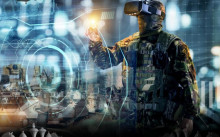
Posted in Blog,National SecurityJuly 12, 2021Comments Off on Feeding the Artificial Intelligence App

Posted in Blog,Book NewsJuly 9, 2021Comments Off on George Galdorisi Announces Release of “Fire And Ice”
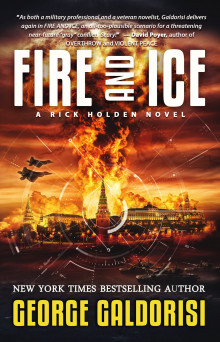
Originally From: The Greater Los Angles Writer’s Society
Fire and Ice is a thriller focused on the political-military tensions created by a modern-day Russia at its vindictive worst. Vladimir Putin emerges as the central character who uses the fulcrum of Belarus to threaten western Europe through a series of lethal and effective attacks on US and European energy sources. Fire and Ice poses the plausible and highly realistic question: Can Putin and his rogue nation be thwarted through the combined efforts of EU and US and political and military might?
Rick Holden and Laura Peters, reunited after several years of being assigned to commands half a world apart, find themselves thrown together by their parent agencies—the CIA and the DoD’s European Command, respectively. Their mission to rescue a captured American is successful, but then they must turn on a dime and race against time to thwart the transfer of weapons of mass destruction to vengeful terrorists.
Fire and Ice is a new entry in the increasingly popular genre commonly known as “FICINT”—imaging future warfare scenarios based on the realities of high-end combat and real-world intelligence, not fantasy. It leaves the reader wondering not if, but when, such a cataclysmic scenario might play out in our lifetimes. Drawing on the cutting-edge military technology he discusses in his recent non-fiction work: AI at War: How Big Data, Artificial Intelligence and Machine Learning Are Changing Naval Warfare, George Galdorisi injects a new level of future warfare reality into Fire and Ice.
 George Galdorisi is a career naval aviator and writer, specializing in “FICINT,” combining fiction writing with current intelligence to envision future warfare. He began this journey almost a decade ago with the New York Times best seller, Tom Clancy Presents: Act of Valor (Penguin), the novelization of the Relativity Media number-one rated movie. This was followed in rapid succession by three more New York Times best sellers in the rebooted Tom Clancy’s Op-Center series: Out of the Ashes, Into the Fire, and Scorched Earth (St. Martins). Continuing in the FICINT tradition, his three most recent thrillers are The Coronado Conspiracy, For Duty and Honor and the just-released (March 2021) Fire and Ice (Braveship Books).
George Galdorisi is a career naval aviator and writer, specializing in “FICINT,” combining fiction writing with current intelligence to envision future warfare. He began this journey almost a decade ago with the New York Times best seller, Tom Clancy Presents: Act of Valor (Penguin), the novelization of the Relativity Media number-one rated movie. This was followed in rapid succession by three more New York Times best sellers in the rebooted Tom Clancy’s Op-Center series: Out of the Ashes, Into the Fire, and Scorched Earth (St. Martins). Continuing in the FICINT tradition, his three most recent thrillers are The Coronado Conspiracy, For Duty and Honor and the just-released (March 2021) Fire and Ice (Braveship Books).
His FININT work—imaging future warfare scenarios based on the realities of high-end combat and real-world intelligence, not fantasy—is supported by his thirty years as a naval aviator, including four command tours and five years as a carrier strike group chief of staff, culminating in two combat tours in the Arabian Gulf. During this final tour he also led the U.S. delegation for military-to-military talks with China’s People’s Liberation Army, Navy. Adding to his ability to harness all-source, open-source, intelligence to support these FICINT efforts, he is currently the Director of Strategic Assessments and Technical Futures at the Navy Information Warfare Center Pacific in San Diego, California.
Other than writing thrillers, George likes nothing more than connecting with readers. You can follow him on Facebook and Twitter, and learn more about his books, blogs and other writing on his website: http://georgegaldorisi.com/—especially his “Writing Tips,”—which offer useful advice for all writers from established authors to future best-selling writers.
Posted in Blog,Wired TechnologyJune 24, 2021Comments Off on Who’s Driving?

Full disclosure: I love to drive. When people started talking about self-driving cars, the first thing I asked myself was: What question is this the answer to?
But people who thought they were the greatest idea ever were undaunted. Predictions about self-driving cars being on the roads in huge numbers by this year were everywhere.
Now we have hit the brakes. I read an article recently, “The Costly Pursuit of Self-Driving Cars Continues On. And On. And On.” It’s subtitle is revealing: “Many in Silicon Valley promised that self-driving cars would be a common sight by 2021. Now the industry is resetting expectations and settling in for years of more work.” Here is how it begins:
It was seven years ago when Waymo discovered that spring blossoms made its self-driving cars get twitchy on the brakes. So did soap bubbles. And road flares.
New tests, in years of tests, revealed more and more distractions for the driverless cars. Their road skills improved, but matching the competence of human drivers was elusive. The cluttered roads of America, it turned out, were a daunting place for a robot.
The wizards of Silicon Valley said people would be commuting to work in self-driving cars by now. Instead, there have been court fights, injuries and deaths, and tens of billions of dollars spent on a frustratingly fickle technology that some researchers say is still years from becoming the industry’s next big thing.
Now the pursuit of autonomous cars is undergoing a reset. Companies like Uber and Lyft, worried about blowing through their cash in pursuit of autonomous technology, have tapped out. Only the deepest-pocketed outfits like Waymo, which is a subsidiary of Google’s parent company, Alphabet; auto giants; and a handful of start-ups are managing to stay in the game.
Posted in Blog,Book News,This WeekJune 23, 2021Comments Off on Admiral’s Almanac Podcast: Interview with George Galdorisi
In this episode I have the honor of sitting down with one of my mentors, Navy Captain George Galdorisi. George is a Leader, Mentor, Strategic Thinker, National Security expert, and author of 15 books. George discusses his latest Rick Holden thriller, Fire and Ice. It is fiction that experts claim helps to strategize the challenges Russia presents in the real world today.
Posted in Blog,National SecurityJune 22, 2021Comments Off on China at Sea
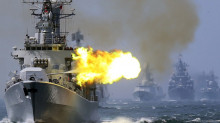
In the late 1990s I had the honor of leading the United States delegation for military-to-military talks with the People’s Liberation Army, Navy (the PLAN).
Our group visited Chinese naval bases and back then, China’s navy was not much of a force. That has changed dramatically in the ensuing two decades.
That’s why I found a recent article, “China’s navy has more ships than the US. Does that matter?” so interesting. Here is how it begins:
Exactly if and when the increasing antagonism between United States and China will boil over into full-on conflict remains anybody’s guess.
But for now, one thing is as clear as the aqua-blue waters that lap up on the shores of China’s man-made islands in the South China Sea: Beijing’s naval fleet is larger than that of the U.S. Navy.
Citing the Office of Naval Intelligence, a Congressional Research Service report from March notes that the People’s Liberation Army Navy, or PLAN, was slated to have 360 battle force ships by the end of 2020, dwarfing the U.S. fleet of 297 ships.
Such numbers are hard to pinpoint because the PLAN doesn’t release public reports on its future shipbuilding efforts like the U.S. Navy does. But according to the CRS, China is on pace to have 425 battle force ships by 2030. Sheer size and numbers carry a quality all their own, and a numerical advantage would be of benefit in a small battlespace like the Taiwan Strait, some China watchers say.
Still, others note that because the U.S. Navy has been doing this a lot longer than the growing Chinese force and is aided by the naval might of America’s allies in the region, the U.S. retains key advantages that extend beyond any mere hull tally.
Posted in Blog,Devastating InnovationJune 17, 2021Comments Off on Think Different

While bookstore (or Amazon warehouse) shelves groan under the weight of books about Silicon Valley, they continue to feed our fascination with the tech industry.
That is why I was drawn to the review of a new book: WHAT TECH CALLS THINKING
An Inquiry Into the Intellectual Bedrock of Silicon Valley. Here is how it begins:
In 2007, the venture capitalist Marc Andreessen argued in a brassy blog post that markets — not personnel, product or pricing — were the only thing a start-up needed to take flight. Teams, he suggested, were a dime a dozen. Products could be barely functional. He even suggested that the laws of supply and demand, the ones that generate price competition, no longer obtained.
The takeaway was something like If they come, you will build it. To get them to come, a founder needs a magnetic concept. Community, say. Connection. Sharing. Markets coalesced around these hazy notions in 2007 and 2008, with the debuts of Twitter, Airbnb, Waze, Tumblr and Dropbox.
In an erudite new book, “What Tech Calls Thinking,” Adrian Daub, a professor of comparative literature and German studies at Stanford, investigates the concepts in which Silicon Valley is still staked. He argues that the economic upheavals that start there are “made plausible and made to seem inevitable” by these tightly codified marketing strategies he calls “ideals.”
There are so many scintillating aperçus in Daub’s book that I gave up underlining. But I couldn’t let “Disruption is a theodicy of hypercapitalism” pass. Not only does Daub’s point ring true — ennobling destruction and sabotage makes the most brutal forms of capitalism seem like God’s will — but the words themselves sound like one of the verses of a German punk-socialist anthem.

The Covid-19 has caused many people to confront death through the loss of friends and loved ones. But even if you are not touched by personal loss, you are likely thinking about your own limited time on this earth more than you were, say, 18 months ago.
The Stoics have a term for this – memento mori. I also wondered about this term and wanted to know more. That’s why I eagerly read a recent article “Meet the Nun Who Wants You to Remember You Will Die.” The subtitle is profound: “Suffering and death are facts of life: “Everyone dies, their bodies rot, and every face becomes a skull.” Here is how the article begins:
Before she entered the Daughters of St. Paul convent in 2010, Sister Theresa Aletheia Noble read a biography of the order’s founder, an Italian priest who was born in the 1880s. He kept a ceramic skull on his desk, as a reminder of the inevitability of death. Sister Aletheia, a punk fan as a teenager, thought the morbid curio was “super punk rock,” she recalled recently. She thought vaguely about acquiring a skull for herself someday.
These days, Sister Aletheia has no shortage of skulls. People send her skull mugs and skull rosaries in the mail, and share photos of their skull tattoos. A ceramic skull from a Halloween store sits on her desk. Her Twitter name includes a skull and crossbones emoji.
That is because since 2017, she has made it her mission to revive the practice of memento mori, a Latin phrase meaning “Remember your death.” The concept is to intentionally think about your own death every day, as a means of appreciating the present and focusing on the future. It can seem radical in an era in which death — until very recently — has become easy to ignore.
Many writers write novels about warfare. Some of them write about the future of warfare. Sadly, most base what they write about on fantastical, made up scenarios that bear no connection with reality. Jeff Edwards is not one of them, His latest thriller follows a long line of riveting, and convincing military thrillers and are informed by his decades of service as U.S. Navy professional. The Damocles Agends is a book you won’t want to miss.
Posted in Blog,Book NewsJune 9, 2021Comments Off on The Next Revolution in Military Affairs? – Review of AI at War
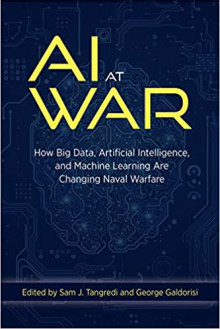
05/31/2021
Recently, USNI press has published a book edited by Sam J. Tangredi and George Galdorisi entitled AI at War: How Big Data, Artifical Intellignece and Machine Learning are Changing Naval Warfare.
The book provides a useful overview to various perspectives on how AI and autonomous systems might shape the way ahead with regard to the evolution of warfare.
I would suggest the might shape point.
In effect, the art of warfare is changing under the impact of several forces for change, not simply how data is managed or how machines might operate as force extenders for manned platforms.
In reality, the book really focuses on command and control, and many of the chapters focus on that subject.
The shift from the land wars back to peer competitor warfare is built around the return of mission command and C2 as the heart of shaping the way ahead for distributed forces.
The standup of Second Fleet in Norfolk and the associated commands under VADM Lewis’s leadership are being crafted into a warfighting force around mission command and distributed C2 and reworking task force concepts.
Autonomous systems and better information management will enhance the lethality, survivability and capability of such a force, but that is the mid-term.
But without working the core concept of operations shifts, adding new machines will not have the impact they might have.
A good way to look at this dynamic is provided in the chapter by Harrison Schramm and Bryan Clark.
“A more disaggregated and reconfigurable force structure would enable a wider variety of potential force presentations. An AI-enabled control system could exploit the composability of a disaggregated force to create greater adaptability for the U.S. military and impose more dilemmas and complexity on an adversary, thereby increasing the opponent’s uncertainty.”
In my work with the Australian Defence Force and the recent Williams Foundation Seminar on Next Generation Autonomous Systems this is a key focus of attention for the ADF.
Reshaping the maritime force to operate as a fleet, and to do so in terms of blue water expeditionary operations is the foundation from which a transition to use effectively autonomous systems within which AI would play a decision guidance role is foundational.
There are several thoughtful chapters on C2 as the U.S. Navy turns its focus to peer warfare.
But as it does so there are three very important considerations which affect big data, AI and its use.
The first is that the peer competitors we are talking about are nuclear powers, so that any consideration of how to manage attacks upon peer adversaries must consider how those attacks affect the calculations of adversaries.
The second is that understanding of how adversaries think and how they might act is part of the calculation which AI processing of data can assist if we indeed have the knowledge to know what we are looking for and what we are looking at.
This is a huge gap as we turn from being Middle East experts to calibrating how authoritarian leaders in Russia and China under the global stress of COVID-19 and the post-globalization era looks like and how best to use military tool sets?
The third is the question of targeting.
There is a good treatment of the targeting or fires solution problem by Michael O’Gara.
He provides a cautious and careful assessment of how AI can help in the decision process to make a fires solution.
As he notes: “AI holds promise in handling resource priorities across domains more seamlessly while being capable of initiating responses based on more accurate and timely threat assessments.”
But of course, the core targeting problem is not simply the speed to attack but also target selection in a crisis management setting.
But if confidence in both the speed and accuracy to attack is high and can be assisted by more rapid and effective data management and decision tools, then that can assist in providing for a wider set of crisis management options, from the standpoint of decision-making confidence as well.
The book does consider as well the problem of ability to spoof AI-enabled systems.
But there is as well the potential for distributed fleets to develop packages which they can deploy to deceive the adversary as well, even in terms of effective operating location.
The US Navy’s Nemesis program is suggestive of such a possibility.
And in considering the future, it is important not to ignore the warfighting advantages our force already has that the adversary does not.
For example, the ability of an 8-ship F-35 formation to fight as a wolfpack, suggests what swarming could deliver in the midterm future.
The ability of U.S. and allied F-35s to operate over large areas like the North Atlantic and the Mid-Pacific to shape a COP and target identification has barely been scratched. These are harbingers of things to come, but they are here now.
The future is now.
The mid-term and long-term future are just that and mostly unknowable.
How well did the forecasters in 2019 do in forecasting 2020?
The book provides a very useful collection of essays which frame ways to think about AI, big data and C2 might change the future of warfare. It is well worth reading.
https://www.usni.org/press/books/ai-war
Author’s Note: In a recently published Australian study on AI and the military, Peter Layton provided an interesting look at how to consider different ways AI-enabled assets might play out on future battlefields.
The conclusion to his study provides a very helpful and balanced look at the way ahead with regard to AI and warfare:
In the near-to-medium term, AI’s principal attraction for military forces will be its ability to quickly identify patterns and detect items hidden within very large data troves. AI will make it much easier to detect, localise and identity objects across the battlespace. Hiding will become increasingly difficult.
However, the technology of contemporary AI has inherent problems. It is brittle, in being able to operate only in the context it has been trained for; it is unable to transfer knowledge gained in one task to another and it is dependent on data. Accordingly, AI when used in real-world situations needs to be teamed with humans. The strengths of AI can then counterbalance the weaknesses in human cognition and vice versa….
As a general-purpose technology, AI is becoming all-pervasive and will over time infuse most military equipment. Such ubiquity though means AI is likely to be initially employed within existing operational level thinking. In the short-to-medium term, it will enable the battlefield, not remake it.
In simple terms, AI’s principal warfighting utility can be expressed as ‘find and fool’. With its machine learning, AI is excellent at finding items hidden within a high-clutter background. In this role, AI is better than humans and tremendously faster. On the other hand, AI can be fooled through various means. AI’s great finding capabilities lack robustness.
AI’s ‘find’ abilities further provide mobile systems with a new level of autonomy, as the AI can analyse its surroundings to discern important operating data. This means that ‘find and fool’ tasks can be undertaken using in-motion and at-rest, AI-enabled systems featuring varying levels of autonomy. AI can bring to modern warfighting enhanced sensors, improved kinetic and non-kinetic kill systems, more convincing deception techniques and a wide array of ways to confuse. In this, it is crucial to remember that AI enlivens other technologies. AI is not a stand-alone actor, rather it works in combination with numerous other digital technologies, providing a form of cognition to these.
If being used for defensive tasks, a large number of low-cost IoT sensors using AI edge computing could be emplaced in the optimum land, sea, air, space and cyber locations in a territory in which an attacking force may move across. From these sensors, a deep understanding would be gained of the area’s terrain, sea conditions, physical environment and local virtual milieu. Having this background data accelerates AI’s detection of any movement of hostile military forces across it….
For Layton, the operational shift which AI-enabled warfare entailed could be understood as a shift from the kill chain to the kill web.
The kill chain model used by contemporary military forces tightly integrates the sense–decide–act logic flow. In contrast, the data flow across the large Internet of Things (IoT) field in the mosaic warfare construct creates a kill web, where the best path to achieve a task can be determined and used in near real-time. The use of the IoT field is then fluid and constantly varying, not a fixed data flow as the kill chain model implies. The outcome is that the mosaic warfare concept provides commanders with highly resilient networks of redundant nodes and multiple kill paths. Moreover, the mosaic concept aims to be scalable; the size and elements of the IoT field can be varied as battlefield circumstances demand.
Posted in Blog,Book NewsJune 7, 2021Comments Off on OUR NEXT WAR AND HOW IT MIGHT UNFOLD By Reginald Blackstone
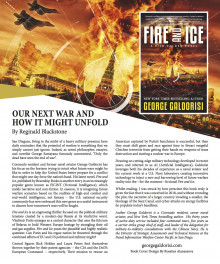
San Diegans, living in the midst of a heavy military presence have daily reminders that the potential of warfare is something that we simply cannot just ignore. Indeed, as noted philosopher, essayist, and novelist George Santayana famously commented, “Only the dead have seen the end of war”.
Coronado resident and former naval aviator George Galdorisi has his focus on the horizon trying to intuit what future wars might be like in order to help the United States better prepare for a conflict that might one day force the nation’s hand. His latest novel, Fire and Ice, published by Braveship Books is another entry in an increasingly popular genre known as FICINT (Fictional Intelligence), which melds narrative and non-fiction. In essence, it is imagining future warfare scenarios based on the realities of high-end combat and real-world intelligence, not fantasy – the U.S. national security community has now embraced this new genre as a useful instrument to discern how tomorrow’s wars will be fought.
Fire and Ice is an engrossing thriller focused on the political-military tensions created by a modern-day Russia at its vindictive worst. Vladimir Putin emerges as a central character that uses the fulcrum of Belarus to hold Western Europe hostage by strangling their oil and gas supplies. Fire and Ice poses the plausible and highly realistic question: Can Putin and his rogue nation be thwarted through the combined efforts of EU and US political and military might?
Central figures Rick Holden and Laura Peters find themselves thrown together by their parent agencies — the CIA and the DoD’s European Command — respectively. Their mission to rescue an American captured by Putin’s henchmen is successful, but then they must shift gears and race against time to thwart vengeful Chechen terrorists from getting their hands on weapons of mass destruction and starting a nuclear war in Europe. Drawing on cutting-edge military technology developed in recent years, and referred to as AI (Artificial Intelligence), Galdorisi leverages both his decades of experience as a naval aviator and his current work at a U.S. Navy laboratory creating innovative technology to inject a new and harrowing level of future warfare reality into the-for the moment-fictional Fire and Ice.
Whilst reading, I was struck by how prescient this book truly is given the fact that it was conceived in 2018, and without revealing the plot, the narrative of a larger country invading a smaller, the blockage of the Suez Canal, and cyber-attacks on energy facilities do populate today’s headlines.
Author George Galdorisi is a Coronado resident, career naval aviator, and New York Times bestselling author. His thirty years of active duty service included four command tours, five years as a carrier strike group chief of staff, and leader of the delegation for military-to-military consultations with the Chinese Navy. He is the Director of Strategic Assessments and Technical Futures at the Naval Information Warfare Center Pacific in San Diego.